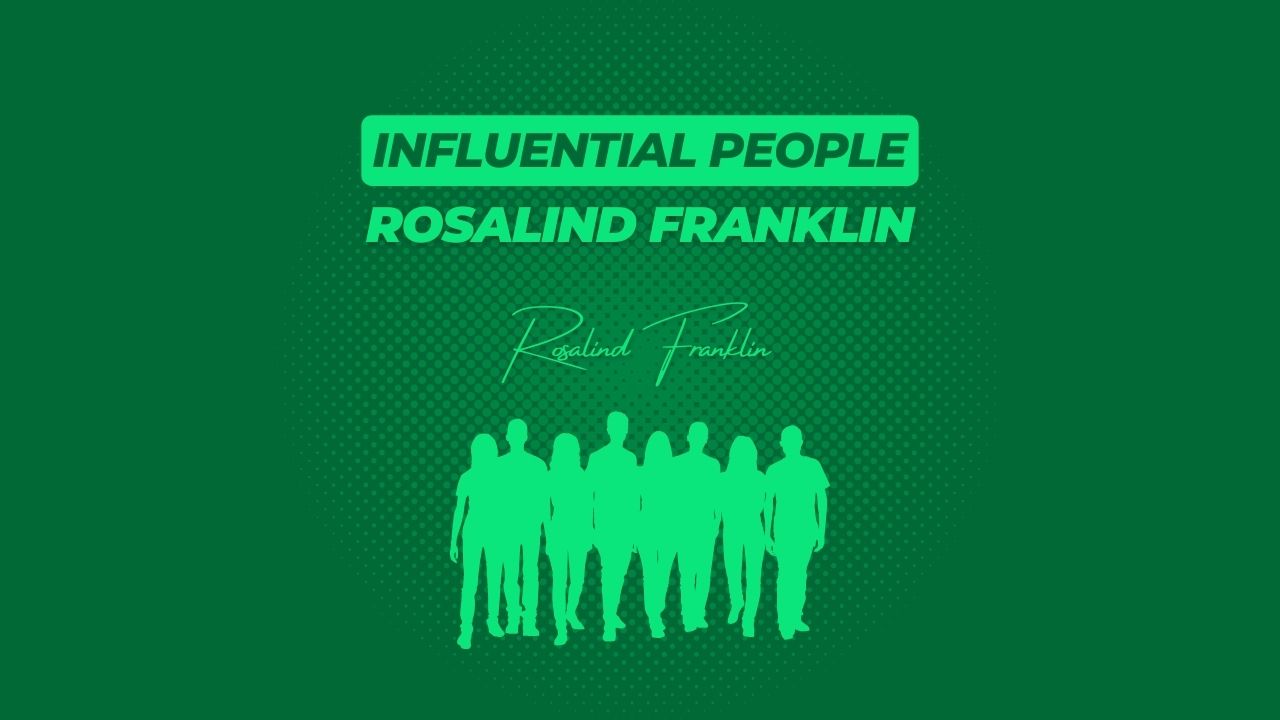Introduction to Rosalind Franklin
Rosalind Franklin remains one of the most influential yet under-recognised figures in the annals of modern science. Her meticulous work, particularly in X-ray crystallography, provided the critical evidence needed to decipher the helical structure of DNA, a discovery that revolutionised biology, genetics, and beyond. Born in 1920, in an era when women’s contributions to science were often overlooked, Franklin’s relentless pursuit of knowledge paved the way for one of the twentieth century’s most significant scientific revelations.
Her role in uncovering the double helix structure of DNA is pivotal, laying the foundational blueprint that has since influenced numerous scientific fields and practical applications. One such modern application surprisingly extends into the realm of online dating, where genetic compatibility has begun to inform matchmaking algorithms, suggesting matches based on biological compatibility. Franklin’s legacy, thus, stretches from the petri dish to the digital age, proving that her work not only unlocked the molecular mysteries of life but also continues to resonate in our understanding of human relationships and connections today. This introduction into her life and work offers a glimpse into the profound impact she has had, not just in science, but in the very way we perceive and interact within the realm of human intimacy.
Early Life and Education
Rosalind Franklin was born into a prosperous and intellectually stimulating family in Notting Hill, London, in 1920. Her upbringing in an environment that valued education and public service profoundly shaped her character and aspirations. From a young age, Franklin exhibited a sharp intellect and a keen interest in the natural world, traits that were nurtured by her family’s encouragement and the resources they provided.
Her educational journey began at one of London’s few girls’ schools that offered an advanced curriculum in physics and chemistry, notably progressive for the time when scientific education for women was often limited. This early exposure to the sciences laid a robust foundation for her future endeavours. Following her successful school years, Franklin progressed to Newnham College, Cambridge, where she further honed her scientific acumen. At Cambridge, she excelled in her studies, immersing herself in the challenging and predominantly male world of scientific research, which further cemented her dedication to pursuing a career in science.
Franklin’s time at Cambridge not only refined her skills in the physical sciences but also underscored her growing passion for research. Her remarkable ability to grasp complex scientific concepts and her meticulous approach to experimental work became her trademark, foreshadowing the significant contributions she would later make to the field of molecular biology. This early period in Franklin’s life highlights her emergence as a formidable young scientist, poised to break new ground in her forthcoming explorations of DNA and beyond.
Key Scientific Contributions
Before her monumental work on DNA, Rosalind Franklin embarked on significant research in the fields of coal and carbon, and later, viruses. Her early research at the British Coal Utilisation Research Association laid the groundwork for her skills in X-ray crystallography, leading to her doctorate from Cambridge. Her studies significantly improved the understanding of the micro-structures of carbon compounds, contributing to the knowledge on the porosity of coal and its applications for gas masks during the war—showcasing her ability to apply scientific inquiry to practical problems.
Franklin’s transition to studying viruses, particularly the tobacco mosaic virus, at Birkbeck College demonstrated her expanding range in X-ray crystallography techniques, which she refined further to produce clearer, more detailed photographs of microscopic structures. Her work here not only contributed to virology but also honed her expertise that would prove crucial in her subsequent DNA research.
At King’s College London, Franklin made her most critical contributions. Her arrival at the college marked the beginning of intense research into DNA. It was here that she captured Photograph 51, an X-ray diffraction image that became a cornerstone in identifying the structure of DNA. This photograph, taken in 1952, unmistakably showed a helical structure, providing the first clear evidence of DNA’s spiral nature. The precision and clarity of Photograph 51 allowed James Watson and Francis Crick to construct their famous model of the DNA double helix—the model that would earn them a Nobel Prize.
However, Franklin’s journey was fraught with challenges. Working in a predominantly male-dominated field, she often faced significant professional obstacles, including lack of recognition and underestimation by her male peers. At King’s College, she navigated a complex relationship with Maurice Wilkins, who mistakenly considered her a subordinate rather than a peer. This professional dynamic, coupled with her intense commitment to her work, sometimes isolated her within the scientific community.
Despite these challenges, Franklin’s meticulous approach and unwavering dedication to her work underpinned her profound impact on the understanding of molecular structures. Her contributions went far beyond the confines of her laboratory, influencing not only the field of genetics but also altering the course of modern medicine and biology.
The DNA Legacy
The elucidation of DNA’s structure is one of the most critical milestones in the history of science, forming the backbone of modern genetics and biotechnology. Understanding the double helix configuration of DNA unlocked the code of life, explaining how genetic information is stored, replicated, and passed on from one generation to the next. This foundational knowledge has catalyzed advancements across various fields, from medicine to agriculture, enabling the development of genetic engineering, cloning, and CRISPR gene-editing technologies.
In the realm of medicine, Rosalind Franklin’s contributions have allowed for breakthroughs in genetic testing, leading to early diagnosis and targeted treatment strategies for genetic disorders. Her work underpins the entire field of genomics, which has transformed our approach to diseases like cancer, enabling personalised medicine that tailors treatment to an individual’s genetic profile.
Extending beyond conventional scientific applications, the impact of DNA understanding permeates even the social sphere of online dating. Modern online dating platforms increasingly explore genetic compatibility as a factor in matchmaking, suggesting that biological compatibility could predict relationship success. While the ethical implications and scientific validity of such applications are debated, the use of DNA-based matching underscores the broad and unforeseen applications of Franklin’s work.
Furthermore, Franklin’s pioneering research laid the groundwork for our current understanding of human biology and the progression of numerous diseases. It has informed approaches in pharmacogenomics, where drug therapies are tailored based on individual genetic profiles, vastly improving treatment efficacy and reducing side effects.
Ultimately, Rosalind Franklin’s legacy in DNA research continues to influence countless aspects of science and daily life. Her meticulous and pioneering work has not only paved the way for critical scientific advancements but also has fostered a deeper understanding of the very blueprint of life, which continues to shape innovations across multiple domains.
Challenges and Controversies
Rosalind Franklin’s scientific career was marked by considerable challenges, notably stemming from the pervasive gender biases of her time. Working in a male-dominated field during the mid-20th century, Franklin often encountered significant professional hurdles. Her contributions were frequently undervalued, and she faced a lack of support and recognition from some male colleagues. This environment was exemplified during her tenure at King’s College London, where she navigated complex dynamics and occasionally strained relationships, particularly with Maurice Wilkins, who was initially unaware that Franklin had been appointed as an equal and not as his assistant.
One of the most significant controversies surrounding Franklin’s work involves the Nobel Prize in Physiology or Medicine awarded in 1962 to James Watson, Francis Crick, and Maurice Wilkins for their work in determining the structure of DNA. This award highlighted a critical omission—Franklin’s indispensable contribution through her X-ray diffraction images, which were crucial in defining the DNA double helix model. Tragically, because the Nobel Prize is not awarded posthumously and Franklin had passed away in 1958, she was not eligible for recognition when the award was given.
In recent years, there has been a concerted effort to reclaim and celebrate Rosalind Franklin’s story and achievements. Her contributions are now widely acknowledged in scientific communities and popular media. Institutions and awards have been named in her honour, such as the Rosalind Franklin University of Medicine and Science in Illinois, and the Rosalind Franklin Medal, which is awarded to outstanding women in science. Moreover, her life and work have been the subject of books, documentaries, and plays, helping to correct the historical oversight and bring her story to a broader audience.
This retrospective recognition reflects a broader societal shift towards acknowledging the contributions of women in science, and ensuring that their legacies are remembered and celebrated. Franklin’s journey and the posthumous recognition of her work underscore the ongoing challenges and progress in addressing gender disparities in the scientific community.
Impact and Recognition
Rosalind Franklin’s legacy in the realm of molecular biology is profound and enduring. Her meticulous work with X-ray crystallography provided the underpinnings for the modern understanding of DNA, which has been instrumental in shaping the entire landscape of genetics, biotechnology, and medical research. Her contributions extend beyond the laboratory, influencing educational methods and ethical considerations in scientific research.
Posthumously, Franklin has received numerous accolades and recognitions that highlight her contributions and serve as a corrective to the oversight of her work during her lifetime. Several prestigious awards have been named in her honour, such as the Rosalind Franklin Award given by the Royal Society, which is awarded annually to an outstanding woman in science, technology, engineering, or mathematics. This award not only recognises scientific achievement but also supports projects that raise the profile of women in STEM.
Institutions have also recognised Franklin’s contributions by naming buildings and lecture series after her. The Rosalind Franklin University of Medicine and Science in North Chicago is dedicated to her memory, promoting research and education in the medical and science fields with an emphasis on community involvement and ethical considerations. Additionally, various scholarships have been established in her name at universities around the world, aiming to encourage and support women pursuing careers in the sciences, thus ensuring that the barriers Franklin faced are progressively dismantled for future generations.
Franklin’s story resonates particularly with women in science, serving both as a cautionary tale and a source of inspiration. Her perseverance in the face of institutional and gender-based challenges, coupled with her exceptional contributions to science, underscores the importance of diversity and equity in scientific research. Her life encourages current and future generations of scientists to pursue their research with tenacity and integrity, regardless of the challenges.
The broader impact of Rosalind Franklin’s work and her story is evident in the ongoing discussions about gender in science and the steps being taken to create a more inclusive and equitable scientific community. By celebrating Franklin’s achievements and the values she exemplified, the scientific world not only honours her memory but also promotes a culture that values contributions based on merit and commitment, paving the way for all aspiring scientists.
Conclusion
Rosalind Franklin’s life and work have left an indelible mark on the world of science and beyond, highlighting her as a trailblazer in molecular biology and a beacon for gender equality in the sciences. Her pioneering use of X-ray crystallography to capture the structure of DNA fundamentally altered our understanding of the genetic blueprint that defines all living organisms. This breakthrough has underpinned advancements in numerous fields, from genetics and medicine to agriculture and forensic science.
Beyond her scientific achievements, Franklin’s impact reverberates in the realm of modern technology, where her work indirectly influences complex algorithms, including those used in online dating platforms. These systems, which sometimes explore genetic compatibility to enhance matchmaking, owe their conceptual underpinnings to the understanding of human DNA—a field that Franklin significantly advanced.
Reflecting on her legacy, Rosalind Franklin is remembered not only for her scientific acumen but also for her role as a subtle advocate for women in science. Despite the considerable challenges and gender biases she faced, Franklin’s dedication to her research and her high standards of excellence set a profound example for future generations. Today, as the scientific community continues to strive for greater inclusivity and recognition of diverse contributions, Franklin’s story serves as both a testament to the struggles faced by women in the past and a hopeful vision for the future.
Rosalind Franklin’s story is a powerful reminder of the need for persistence and integrity in science. Her legacy continues to inspire scientists around the globe, motivating them to pursue their investigations with courage and meticulous care, ensuring that the path she helped pave is followed and expanded upon by those who come after her.






